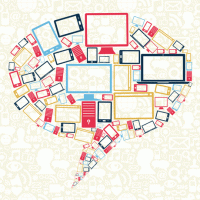Technology in Schools: Defining the Terms
The topic of technology can be confusing. Maybe the most confounding part is reaching a definition of "technology" that works to foster healthy discussion of the best ways that schools can use technology to enhance learning.
The 2014 National Assessment of Educational Progress (NAEP) Technology and Engineering Literacy framework defines technology as "any modification of the natural world done to fulfill human needs or desires." Interestingly, the definition says nothing about iPads, tablets, laptops, Google, Facebook or Instagram.
In fact, the focus of the framework rests on a much larger concept of the ways in which humans have altered and continue to alter the “natural world” with the goal of fulfilling "needs and desires." Technology is much bigger and more complex than a single device or site.
Peril or Possibility
The NAEP definition stands apart from the ways in which schools and parents often approach the topic of technology. When technology arises in discussion among educators and parents, the conversation often turns to an issue of human behavior, centered around distraction, temptation, addiction, misuse, multi-tasking, etc. Annie Murphy Paul's recent article about the perils of multi-tasking focuses on many of these issues.
Sure, there are also discussions that bring opportunity and possibility to the surface, such as personalized, customized learning, access, equity, creativity and innovation. But whether the conversation is about peril or possibility, it has yet to land on a working, agreed-upon definition of technology.
Technology can too easily be lumped together with behavior, parenting, schools, society, economics and culture, and the conversation can get twisted and turned in many different directions. Unfortunately, the idea of technology carries voltage and sparks strong responses.
The NAEP framework defines technology literacy as "the capacity to use, understand, and evaluate technology as well as to understand technological principles and strategies needed to develop solutions and achieve goals."
This is a sound working definition and a noble literacy objective.
If we flip the statement and turn it into an essential question such as "What are the principles and strategies needed to develop solutions and achieve goals?" -- then we have a starting point for a conversation about the role of technology in schools to "develop solutions and achieve goals."
In a professional development discussion with teachers, school leaders can pose this question and start with principles and strategies.
Principles and Goals
What are the fundamental, basic, non-negotiable principles upon which to base technology in schools? To name a few possibilities:
- Differentiated learning
- Personalization and customization
- Depth and complexity
- Digital citizenship
- Collaboration
- Flipped teaching
- Research
- Organization
Inside of these principles, schools can begin to articulate goals around developing strategies to achieve these goals with technology as a tool.
And the goals and strategies may look different in different disciplines. For example, a math class might use an online, customized math program like ALEKS, IXL or Khan Academy to allow students to move at different levels and pacing, with the goal of differentiated learning. Or, a science class might employ Google Documents around the goal of collaboration when conducting a lab.
Separating Needs from Desires
The ability to "evaluate technology" is critical for teachers to consider. Technology does not have to appear in every lesson or unit. The key driver needs to be the learning goal, and technology can play a role in achieving that goal. The expectation is not that technology is used every day in a school with iPads, tablets or laptops. Instead, the process for developing curriculum needs to include the evaluation of technology as a tool to enhance the learning experience for the students. Blogger Chris Lehmann states, "Technology should be like oxygen: ubiquitous, necessary and invisible."
Having the conversation with "evaluation" in mind, coordinated with clear thinking around "principles and strategies," will help to foster healthy thinking about the role of technology and learning.
Additionally, employing the lens of "needs" vs. "desires" can be instructive. For example, a student might "need" to write an English class paper in Pages on the iPad. Yet that same student may have the "desire" to listen to an inappropriate song or play an inappropriate game. In using a mobile device at school, educators can facilitate opportunities for students to examine the difference between needs and desires, helping to create safe and acceptable norms for use at school and preserving the need for balance.
In reviewing devices and uses in schools, educators can first take a look at their own relationship with technology around needs and desires, and then carry this into working with students, to avoid the "do as I say but not as I do" mode. We all face the challenge of being sucked into the vortex of the device, whether it's to text, email, shop, listen to music, play a game or just explore.
What are ways that you have had the conversation about technology in your school? And what definition of technology are you using?
